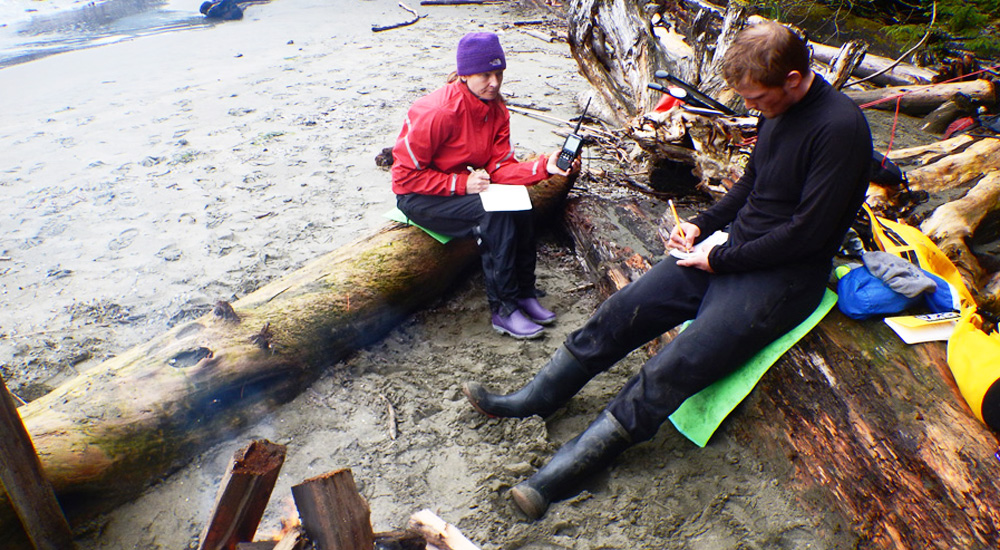Mitigating consequences in the wilderness: The basics of wilderness first aid

February 24th, 2017
Oh, spring is almost here and what a special time of year it is! Not only are the days getting longer, the weather getting warmer, and the forest beginning to bloom and regenerate. It’s also a time of adventure with many new and old faces making their way to this very special area of the world; to play, work, explore all usually with the common theme of enjoying the beauty and allure of the outdoors where the mountains descend into the vast Pacific Ocean.
With the excitement of being out on the land and the water, it can be easy to overlook the fact that we take certain risks whenever we’re out enjoying the wilderness. This is to regardless if it’s your first time out of the city or you are an experienced west coaster familiar with the ocean and rainforest.
Unfortunately it’s when things go wrong in the outdoors that it becomes apparent that it’s easy to come up with a high-risk solution to a low-risk medical problem. Like performing a risky rescue putting yourself and the group in the way of more harm as a result of dealing with a minor wound. This is definitely understandable; being in the outdoors presents constantly changing environmental factors combined with people’s emotions and the difficulty of a rescue itself. Things are never going to be easy if you run into medical problems in the wilderness, but with an understanding of some basic guiding principles and time invested into training you can build confidence and make good decisions not only for the patient but also for the whole group.
Deciding if an injury or illness is serious or not serious are the fundamentals of good outdoor medicine. If we’re anxious, panicked and inexperienced it can be hard to know the seriousness of a medical problem. Building a systematic approach to assessing a situation and a patient allows us to focus in on what’s important. So by not getting thrown off by all the distractions around us we can focus on what’s urgent and make a clear plan.
We can start by making a list, let’s get the facts written out in front of us. One way of doing this is by taking SOAP notes. SOAP stands for Subjective, Objective, Assessment and Plan. Going through this process will allow us to start to make sense of what’s going on and deal with what’s urgent.
Starting off we can group information on patient assessment and history into two groups Subjective; what you learn from looking around and talking to the people involved, and Objective; what you learn from examining the patient (there’s a whole process with this as well which we won’t get a chance to get into here).
Our next step is to make a list of the existing problems the assessment found. So Assessment stands for list of assessed problems. These can be medical problems, but they may also be logistical or environmental problems. If someone has a broken wrist, that is one problem, but they may also be stuck on a steep embankment they fell down, and there’s one hour of daylight left with the temperature dropping quickly. Each of these other factors is another problem. Listing all these problems individually will allow us to tell more clearly which ones we need to deal with first. Once we’ve written out our assessment in the form of a problems list we can also note what anticipated outcomes each problem will have if it’s not dealt with. The broken wrist may result in pain, swelling, or ischemia (poor circulation to that body part). The light will cause problems with travel in general whether its removing the person from the embankment or getting them out of the woods. The dropping temperature may lead to hypothermia. We can now see that even though we may be concerned about the broken wrist, there are potentially other more urgent problems that we need to deal with.
Finally we will make a Plan to deal with each of these problems, what are we going to do? Our plan should consider the resources and abilities of our group. We’ll use our resources to keep the patient and the group warm. We’ll use the existing light to move the patient out of any dangerous surroundings. We’ll deal with the broken wrist once we’ve dealt with these other more urgent problems.
S – Subjective: What do your surroundings and the people around tell you.
O – Objective: What do you find when you examine the patient.
A – Assessment: List of existing problems from your assessment.
P – Plan: What actions do you need to take to treat each problem and prevent anticipated problems.
Even though I’ve just skimmed the surface of how we can act when medical problems occur in the wilderness, hopefully I’ve got us thinking about the idea that even though experience, health and confidence may help decrease the probability of something going wrong. It’s rescue skills training that will allow us to mitigate the consequences if something does go wrong. Having respect for the environment that we’re in and developing an understanding of effective systems to help in an emergency will allow you to be not only more confident on your outdoor adventures, but also help protect you and the group you’re with. Here’s to enjoying life in one of the most beautiful areas of the world in a safe and prepared way.
Emre Bosut is stoked to bring wilderness first aid to the west coast as part of T’ashii Paddle School’s first aid program.